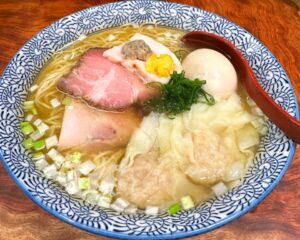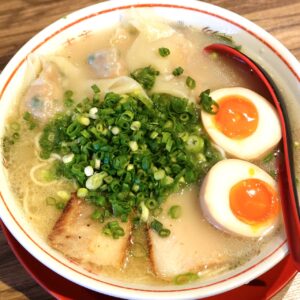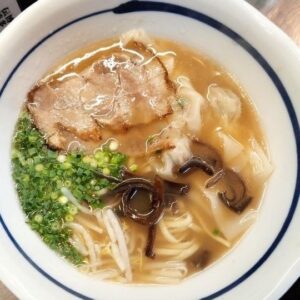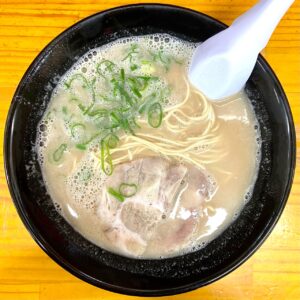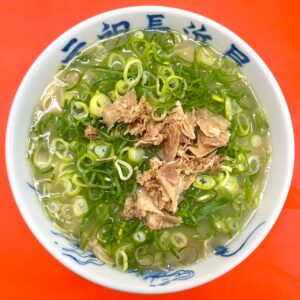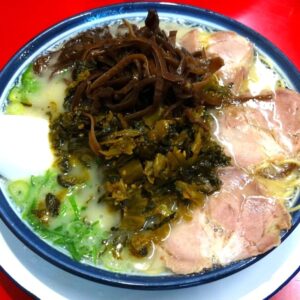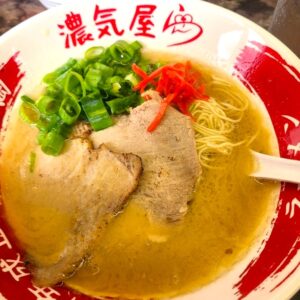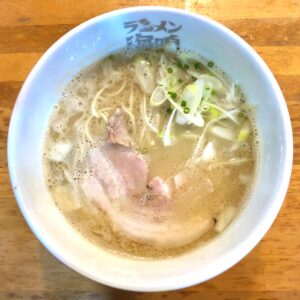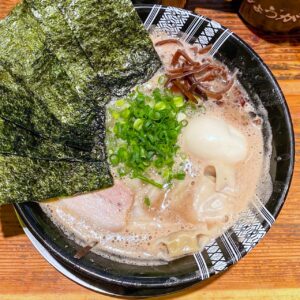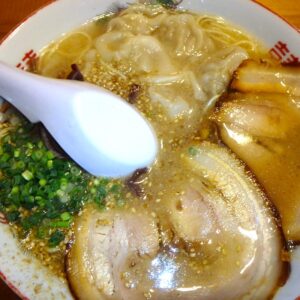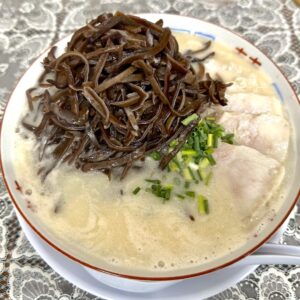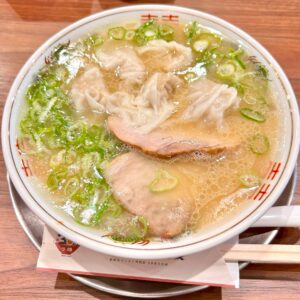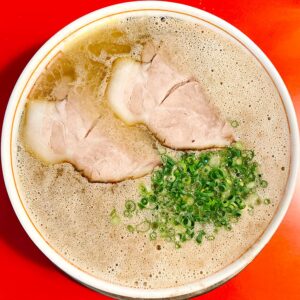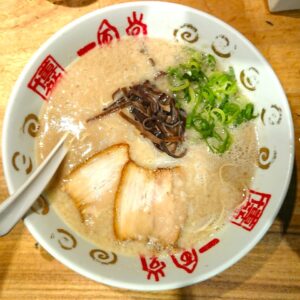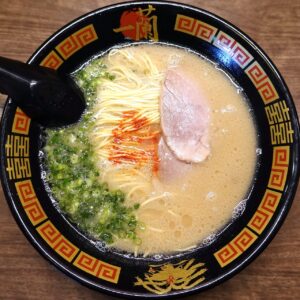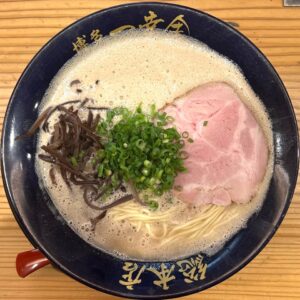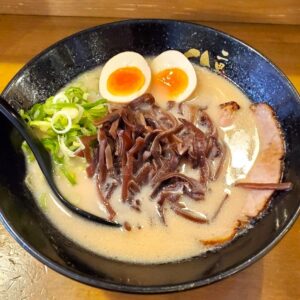Hakata Ramen (Fukuoka Pref.)
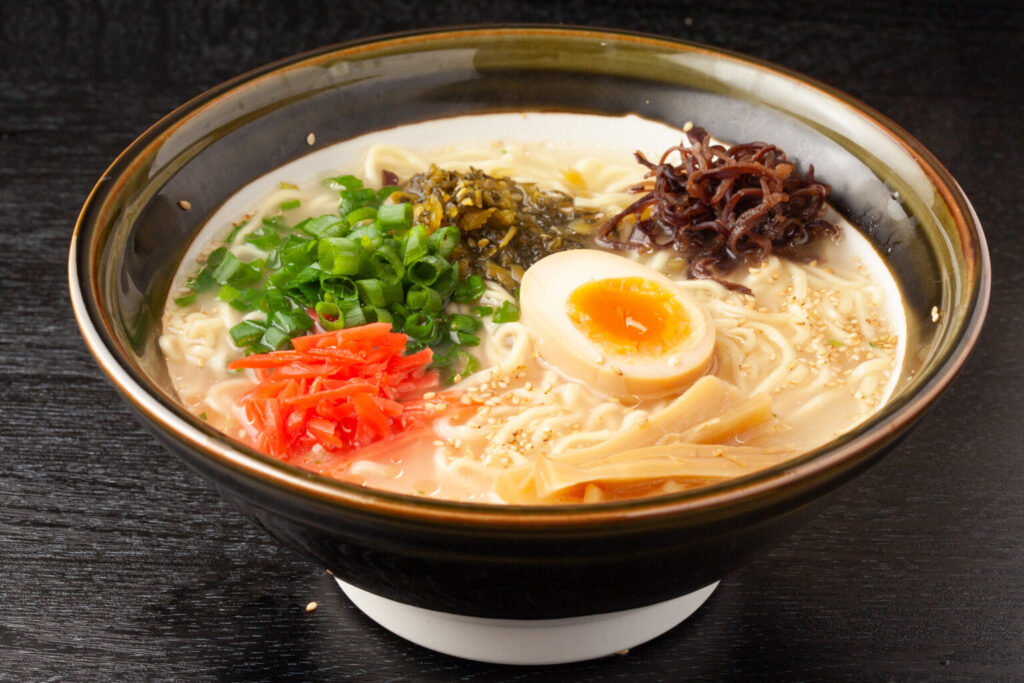
What is Hakata Ramen(博多ラーメン)?
It is a local ramen that originated in Fukuoka City, and refers to the so-called “tonkotsu ramen(豚骨ラーメン),” which uses pork bone soup and thin straight noodles. The cloudy pork bone soup is rich and thickened by the gelatin that has dissolved from the pork bones. The ultra-thin straight noodles have a low water content and are not chewy and powdery. In addition, the amount of noodles is small at about 100g because it absorbs the soup and spreads easily. Many shops allow you to specify the degree of boiling of the noodles, and they are called
●”Bari Kata(バリカタ)” = Very Hard,
●”Kata(カタ)” = Hard,
●”Futsuu(普通)” = Regular,
●”Yawa(やわ)” = Soft,
●”Bari Yawa(バリやわ)” = Very soft,
depending on the degree of hardness. Toppings are provided at the table, and in addition to chashu pork and chopped green onions, you can freely add things like takana mustard greens, pickled ginger, and sesame seeds.
Because the amount of noodles is small, many shops have “Kaedama” (替え玉 another helping of noodles), and some shops offer services such as 1 Kaedama noodle for free.
By the way, there are harder specification for how to boil noodles, so let me write them down along with the approximate boiling time.
●”Harigane(ハリガネ)” – The wire; the core remains in the noodles, and you can also feel the flavor of wheat. (7-15 seconds)
●”Konaotoshi(粉落とし)” – Powder removal; just remove the powder from the noodles, leaving the core almost as it was before boiling. Also known as “Kakiage” (3-7 seconds)
●”Yuge Do-shi(湯気通し)” – Through the steam; the state of the noodles is almost the same as raw noodles, and you can feel the wheat flavor most strongly. (3 seconds)
Low hydration thin noodles go well with cloudy pork bones.
The history of white cloudy soup is almost the same as Kurume(久留米), so why is Hakata ramen more famous nationwide? The size of the market in Kurume itself may have had an impact, but it’s probably due to Hakata ramen’s early entry into Tokyo and the effects of instant ramen. A instant ramen “Umakacchan(うまかっちゃん)” was born in 1979 from House Foods(ハウス食品).
“Nanden Kanden(なんでんかんでん)” and “Fukuchan(ふくちゃん)” opened in 1984 as Hakata ramen shops in Tokyo. From this point on, there was an excitement in the Kanto region that could be called the Hakata ramen boom. Unfortunately, Kurume did not have enough shops in the metropolitan area to spark a boom.
The history of ramen in Fukuoka is surprisingly old. It is said that the first yatai food cart called “Sanmaro(三馬路)” was established around 1941. In 1946, “Hakatasou(博多荘)” and “Akanoren(赤のれん)” began operating. However, “Hakatasou(博多荘)” is not a cloudy soup, but a soup that follows the style of Chinese cuisine. “Sanmaro(三馬路)” has already closed its doors, but “Umauma(うま馬)” is a follower of that trend, and the soup is not cloudy either. The originator of cloudy tonkotsu soup is “Aka Noren(赤のれん).”
Unfortunately, however, “Aka Noren(赤のれん)” closed in 1986. Currently, his eldest son is serving “Original Aka Noren Setsuchan Ramen(元祖赤のれん・節ちゃんラーメン)”. “Sanmaro(三馬路)” and “Hakatasou(博多荘)” had a clear soup, and “Aka Noren(赤のれん)” had a cloudy soup, but today, Hakata ramen refers to a cloudy tonkotsu soup that rarely uses chicken or fish. The noodles are thin, straight, and low hydrated. The green onions in the filling are finely chopped all-purpose green onions. It is said that “Nonkiya(のんき屋)” was the first to put pickled ginger and Takana mustard greens on the table.
The oldest ramen shop in Nagahama(長浜) is “Ganso Nagahamaya(元祖長浜屋)”, which was founded in 1953. The number of ramen shops increased mainly in the wholesale market, and Nagahama ramen was formed. It was said that Nagahama ramen and Hakata ramen were slightly different, but recently it seems that there isn’t much difference between them. Nagahama noodles were originally made thinner so that they could be boiled quickly to appeal to impatient people in the market, so Nagahama became extra-fine noodles. It was also in Nagahama that the innovative system of Kaedama(替え玉,another helping of noodles) was devised, in which the initial amount was reduced because it would stretch if it was thin.
There are several trends that are currently popular in Hakata. “Daruma(だるま)”, “Hidechan Ramen(秀ちゃんラーメン)”, and “Hacchan(八っちゃん)” are made by parents and children and their relatives, and are rich and oily ramen.
Although “Ippudo(一風堂)” is run by a company, it does not feel like a chain store, and is extremely popular among young people. “Ichiran(一蘭)”, the original chili pepper ramen, is on par with Ippudo. The secret sauce is unique, but the interior layout is also innovative. It is separated from the seat next to it by a board, making it a semi-private room. Apparently the idea was to allow people to eat without worrying about other people, but I was surprised when I tried it for the first time. It opened in Roppongi in 2001, and the number of shops increased the following year, and like Ippudo, it has become a globally popular shop.
Speaking of Hakata, we must not forget the existence of street ramen stalls that are popular in places such as Nakasu(中州), but they have been disappearing over the years because they can only last for one generation from the current owner. It’s a sad story.
Other than that, “Fukuchan Ramen(ふくちゃんラーメン)” (not related to the Kanto chain store) is my favorite Hakata ramen shop. Although it has become more like an izakaya, “Gochoume(呉朝明)” is also unique. There is also a shop in Hakata that is popular for its soy sauce flavor, and these days it is called “non-tonkotsu(非豚骨)”.
“Sanmaro(三馬路)” is the original Hakata ramen shop, which is not pork bone type (non-tonkotsu), but it was revived after operating as a rented space from the pedigree shop “Hakata Umauma(博多うま馬)”. In 2021, it opened as an independent shop in Kanda, Tokyo and has gained popularity.
Ramen-Japan / Examples of Ramen Shops
Examples of the long-established Hakata ramen shops
Examples of popular Hakata ramen shops
Examples of Hakata ramen shops with multiple Shops
Examples of Hakata ramen shops in the metropolitan area
-
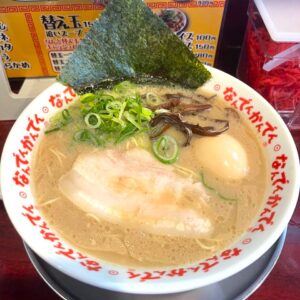
Nandenkanden Nishi-Shinjuku Shop (なんでんかんでん西新宿店 Shinjuku Ward, Tokyo/Shinjuku Nishiguchi Sta.)
-
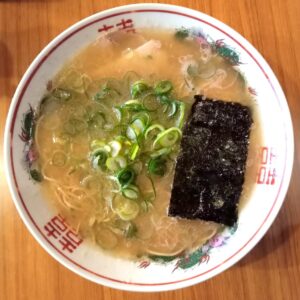
-

Hakata Nagahama Ramen Tanaka Shoten (博多長浜らーめん 田中商店 Adachi Ward, Tokyo/Rokucho Sta.)
-
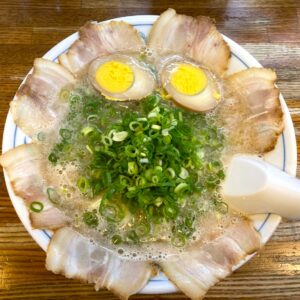
Hakata Ramen Barikote (博多ラーメン ばりこて Suginami Ward, Tokyo/Higashi Koenji Sta.)
-
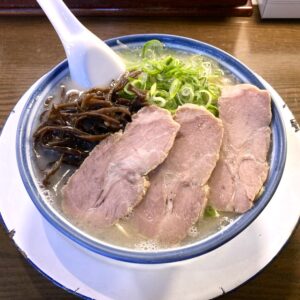
Hakata Ramen Shibaraku Nihonbashi Shop (博多ラーメン しばらく 日本橋店 Chuo Ward, Tokyo/Suitengu-mae Sta.)
-
